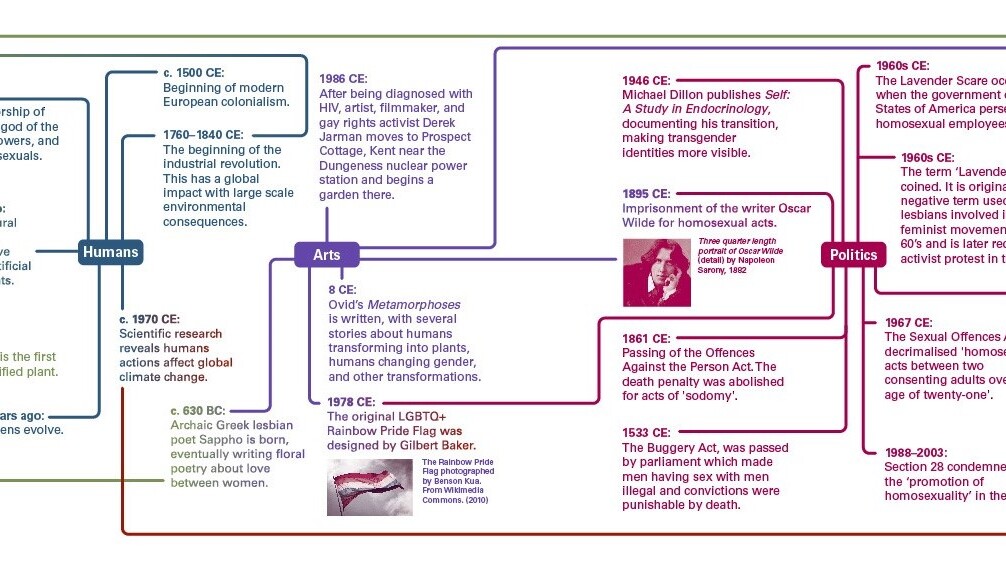6 billion years ago: The first photosynthetic bacteria emerge on earth.
7 billion years ago: Algae first evolve releasing oxygen into the atmosphere.[1]
475 million years ago: Earliest land plants (evidenced in the form of fossilised spores).[2]
383 million years ago: Ferns begin to emerge.[3]
256 million years ago: Early flowers on plants begin to develop.[4]
252 million years ago: Insects begin consuming plant pollen.[5]
200,000 years ago: Homo sapiens
10,000 years ago: Human agricultural practices begin applying selective breeding and artificial selection to plants.[6]
630 BC: Archaic Greek lesbian poet Sappho is born, eventually writing floral poetry about love between women.
100 BC: Beginning of worship of Xochipilli, Aztec god of the arts, prince of flowers, and patron of homosexuals.[7]
8 CE: Ovid’s Metamorphoses is written, with several stories about humans transforming into plants, humans changing gender, and other transformations.
1500 CE: Beginning of modern European colonialism.[8]
1533 CE: The Buggery Act, was passed by parliament which made men having sex with men illegal and convictions were punishable by death.
1673 CE: Chelsea Physic Garden is founded.
1737–1739 CE: Botanical artist Elizabeth Blackwell publishes A Curious Herbal, with illustrations based on plants found at Chelsea Physic Garden.
1760–1840 CE: The beginning of the industrial revolution. This has a global impact with large scale environmental consequences.
1861 CE: Passing of the Offences Against the Person Act. The death penalty was abolished for acts of ‘sodomy’.
1895 CE: Imprisonment of the writer Oscar Wilde for homosexual acts.
1944 CE: Queer lichenologist Elke Mackenzie collects a sample of the only known permanently submerged lichen Verrucaria serpuloides.[9]
1946 CE: Michael Dillon publishes Self: A Study in Endocrinology, documenting his transition, making transgender identities more visible.
1952 CE: Alan Turing publishes the article, ‘The Chemical Basis of Morphogenesis’, where he describes how patterns occur in nature, such as stripes and spot patterns in flower petals.
1960s CE: The Lavender Scare occurs, when the government of United States of America persecuted homosexual employees.
1960s CE: The term ‘Lavender Menace’ is coined. It is originally a negative term used to describe lesbians involved in the feminist movement in the late 60’s and is later reclaimed by activist protest in the 70’s.
1965 CE: Gillian Cox , queer mycologist, publishes The Generic Names of Uredinales contributing greatly to the naming of rust fungi.
1967 CE: The Sexual Offences Act decrimalised ‘homosexual acts between two consenting adults over the age of twenty-one’.
1970 CE: Scientific research reveals human actions affect global climate change.[10]
1978 CE: The original LGBTQ+ Rainbow Pride Flag was designed by Gilbert Baker.
1983 CE: A tobacco plant is the first genetically modified plant.
1986 CE: After being diagnosed with HIV, artist, filmmaker, and gay rights activist Derek Jarman moves to Prospect Cottage, Kent near the Dungeness nuclear power station and begins a garden there.
1988–2003: Section 28 condemned the promotion of homosexuality in the UK.
2010 CE: Queer Ecologies: Sex, Nature, Politics, and Desire by Catriona Mortimer-Sandilands and Bruce Erickson is published.
2015 CE: Queer Theory for Lichens by David Griffiths published.
2020 CE: The Science Underground: Mycology as a Queer Discipline by Patricia Kaishian and Hasmik Djoulakian published.
2022 CE: A Dash of Lavender launches at Chelsea Physic Garden in collaboration with Queer Botany
[1] https://www.bbc.co.uk/bitesize/guides/zg4qfcw/revision/2
[2] https://eprints.whiterose.ac.uk/106/
[3] https://www.amerfernsoc.org/about-ferns
[4] https://www.sciencedaily.com/releases/2018/02/180205092926.htm
[5] https://nph.onlinelibrary.wiley.com/doi/10.1111/j.1469-8137.2006.01864.x
[6] https://www.britannica.com/topic/agriculture
[7] https://www.atlasobscura.com/places/xochipilli
[8] https://www.britannica.com/topic/Western-colonialism

